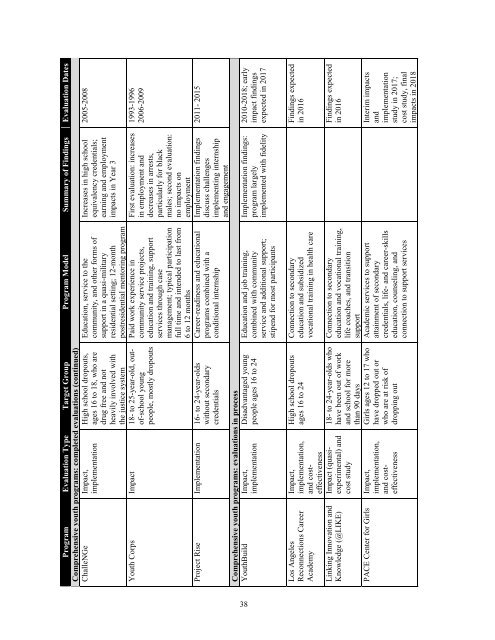Opportunity Youth: Disenfranchised Young People
Opportunity Youth: Disenfranchised Young People
Opportunity Youth: Disenfranchised Young People
Create successful ePaper yourself
Turn your PDF publications into a flip-book with our unique Google optimized e-Paper software.
Findings expected<br />
in 2016<br />
Findings expected<br />
in 2016<br />
Interim impacts<br />
and<br />
implementation<br />
study in 2017;<br />
cost study, final<br />
impacts in 2018<br />
38<br />
Program Evaluation Type Target Group Program Model Summary of Findings Evaluation Dates<br />
Comprehensive youth programs: completed evaluations (continued)<br />
ChalleNGe Impact,<br />
2005-2008<br />
implementation<br />
High school dropouts,<br />
ages 16 to 18, who are<br />
drug free and not<br />
heavily involved with<br />
the justice system<br />
<strong>Youth</strong> Corps Impact 18- to 25-year-old, outof-school<br />
young<br />
people, mostly dropouts<br />
Project Rise Implementation 16- to 24-year-olds<br />
without secondary<br />
credentials<br />
Comprehensive youth programs: evaluations in process<br />
<strong>Youth</strong>Build Impact,<br />
implementation Disadvantaged young<br />
people ages 16 to 24<br />
Education, service to the<br />
community, and other forms of<br />
support in a quasi-military<br />
residential setting; 12-month<br />
postresidential mentoring program<br />
Paid work experience in<br />
community service projects,<br />
education and training, support<br />
services through case<br />
management; typical participation<br />
full time and intended to last from<br />
6 to 12 months<br />
Career-readiness and educational<br />
programs combined with a<br />
conditional internship<br />
Education and job training,<br />
combined with community<br />
service and additional support;<br />
stipend for most participants<br />
Increases in high school<br />
equivalency credentials;<br />
earning and employment<br />
impacts in Year 3<br />
First evaluation: increases<br />
in employment and<br />
decreases in arrests,<br />
particularly for black<br />
males; second evaluation:<br />
no impacts on<br />
employment<br />
Implementation findings<br />
discuss challenges<br />
implementing internship<br />
and engagement<br />
Implementation findings:<br />
program largely<br />
implemented with fidelity<br />
1993-1996<br />
2006-2009<br />
2011- 2015<br />
2010-2018; early<br />
impact findings<br />
expected in 2017<br />
Los Angeles<br />
Reconnections Career<br />
Academy<br />
Linking Innovation and<br />
Knowledge (@LIKE)<br />
Impact,<br />
implementation,<br />
and costeffectiveness<br />
Impact (quasiexperimental)<br />
and<br />
cost study<br />
PACE Center for Girls Impact,<br />
implementation,<br />
and costeffectiveness<br />
High school dropouts<br />
ages 16 to 24<br />
18- to 24-year-olds who<br />
have been out of work<br />
and school for more<br />
than 90 days<br />
Girls ages 12 to 17 who<br />
have dropped out or<br />
who are at risk of<br />
dropping out<br />
Connection to secondary<br />
education and subsidized<br />
vocational training in health care<br />
Connection to secondary<br />
education and vocational training,<br />
life coaches, and transition<br />
support<br />
Academic services to support<br />
attainment of secondary<br />
credentials, life- and career-skills<br />
education, counseling, and<br />
connection to support services

















